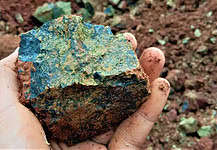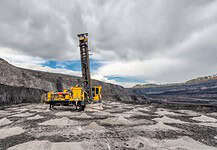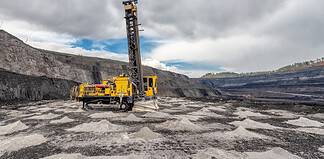FMG’s third chief executive Elizabeth Gaines. All images: FMG.
BY ELIZABETH FABRI
THE resignation of Fortescue Metals Group (FMG) long-term boss Nev Power in February marked the end of an era for the iron ore giant. But it hasn’t taken long for new chief Elizabeth Gaines to begin paving a legacy of her own, as FMG diversifies into new markets and commodities, and advances its $US1.275billion Eliwana project.
Less than six months since her promotion from chief financial officer to chief executive, Elizabeth Gaines has settled well into the FMG driver’s seat.
When announced as Nev Power’s replacement back in November, it was clear Ms Gaines had some big shoes to fill – who can forget Mr Power’s resolute leadership in 2012/2013, when FMG was strapped for cash during the market downturn?
And just like her immediate predecessor, Ms Gaines would be stepping into the role inheriting a unique set of challenges; namely the steep discounts FMG was receiving for its lower grade 58 per cent ore in China.
In the first half of FY18, FMG’s net profit slid 44 per cent. Price realisations for its ore decreased from 86 per cent to 68 per cent of the 62 per cent CFR Platts index as Chinese steel producers increasingly favoured higher grade ore.
The challenges, while not comparable to those experienced during the early years of Mr Power’s tenure, would test the fresh executive team.
Since stepping into the new role in February, Ms Gaines has made it her mission to steer the company towards prosperity, identifying key opportunities for growth.
The first has been expanding FMG’s customer base in new markets, to partially offset the widening gap between the prices received for high grade and low grade ore from China.
In its March quarterly results, FMG revealed it had more than doubled the amount of iron ore it exported outside of China, with non-China markets now accounting for 11 per cent of its total shipments; up from 5 per cent last financial year.
The growth extended to new customers in India—now the third largest producer of steel globally ahead of the US – as well as customers throughout broader South-East Asia like Vietnam and Indonesia.
And in a recent trip to China, Ms Gaines said the ore grade price spread would narrow in time.
“We’ve seen one of the drivers for that spread (between the higher grade and the lower grade ores) has been the high profitability of the Chinese steel mills,” Ms Gaines told Bloomberg TV.
“Our view, and we’re hearing this from our customers, [is that] as profitability comes under pressure they will be chasing the very high value in use (the 58 per cent grade) ore.”
FMG also cited in its March quarterly report that profit margins for China’s steel mills had in fact declined from the peaks reached in the December 2017 quarter.
“There are now signs that steel mills are refocussing on costs resulting in increased demand for Fortescue’s high value-in-use lower iron content ores,” the company stated.
Yet, it seems reduced discounts could be a while away for the Pilbara producer.
During the March quarter, the average realised price for contracts entered was 62 per cent of the benchmark Platts 62 CFR index, while in the first half of FY18 this averaged at 68 per cent.
Several months back, FMG also amended its iron ore price guidance to 65 per cent of the benchmark price for FY18; a 35 per cent gap compared to what was between 10 and 15 per cent two years ago.
Moving into FY19
With weeks to go until end of financial year, the next question is: will FMG meet its production and C1 costs guidance?
In the first half of FY18, FMG shipments were sitting at 84.5 million tonnes, and by the end of the March quarter year to date shipments had risen to 123.2mt.
FMG has assured investors it will meet its guidance of 170mt and C1 costs of between $US12 and $US12.50 per wet metric tonne.
However, rocky results during the March quarter have triggered caution, with a 4 per cent dip in shipments (38.7mt) and a 9 per cent rise in unit costs to $US13.14/t compared to the previous quarter.
The small slump – attributed to higher fuel costs, a higher Australian dollar, maintenance and equipment downtime— was softened somewhat by the announcement FMG had exported its one billionth tonne of iron ore in April; a decade after Cloudbreak’s first commercial shipment from Port Hedland.
Ms Gaines said the shipment of one billion tonnes was a “testament to everyone’s hard work, dedication and innovation”.
“Our strategic goals of investing in the core long term sustainability of the business while pursuing low cost growth options are firmly in our sights as we continue to generate strong margins, leveraging Fortescue’s position at the lowest end of the global cost curve,” she said.
One of the measures to drive efficiencies is the company’s autonomous strategy.
In the March quarter, the team commissioned the first of its autonomous haulage fleet (AHS) at its Christmas Creek operation, with seven trucks now converted.
“Together with the relocatable conveyor at Cloudbreak, the ongoing rollout of AHS at the Chichester Hub is set to contribute to further productivity and efficiency improvements across the business,” Ms Gaines said.
Growth Options
FMG was also a step closer to advancing its 30mtpa $US1.275billion Eliwana deposit as the replacement project for its depleting Firetail mine in the Pilbara.
Late last year, the FMG board was faced with a decision: extend the rail line from its Solomon Hub project 130km west to the Eliwana deposit, or develop a new operation at Nyidinghu about 40km south of its Chichester Hub to the east.
The Eliwana project, 90km from Tom Price, offered more product options, better capital and operating costs and quicker timeline to market.
Eliwana will also be a key contributor to enable FMG to achieving a higher 60 per cent iron grade product.
In late May, the FMG board approved the development of the mine, 30mtpa dry ore processing facility, and 143km rail project, with production to begin in December 2020.
FMG has completed a definitive feasibility study (DFS) and was now moving into detailed design and securing approvals for two public environmental reviews and a mining proposal.
Ms Gaines said the project was important to FMG and the State of WA, creating up to 1900 jobs during construction, and 500 full time positions once operational.
“Development of the Eliwana Project will maintain Fortescue’s low cost status, providing us with greater flexibility to capitalise on market dynamics while maintaining a minimum 170 million tonnes per annum production rate over 20 years,” Ms Gaines said.
FMG also has a 60 per cent interest in the Iron Bridge magnetite project in the Pilbara, another area of focus.
FMG was currently progressing feasibility studies with a decision, in conjunction with Fortescue’s Joint Venture partners, expected during calendar year 2018.
The company was also actively exploring other areas in the Pilbara, NSW, South Australia, Ecuador, Columbia and Argentina in not only iron ore but lithium, copper and gold.








































